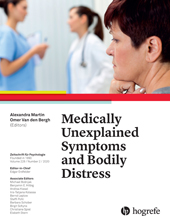Do Women With Severe Persistent Fatigue Present With Fatigue at the Primary Care Consultation?
Abstract
Abstract. Recent studies have shown underdiagnosis of severe persistent fatigue in primary care. To study how patients with severe persistent fatigue present in primary care and whether they differ from patients with less severe fatigue and patients with no fatigue. A 4-year retrospective database study combined with a questionnaire, including all female patients 25–50 years (n = 917) who are registered in one primary care group practice. Based on the results of a validated self-administered questionnaire, patients were divided into three groups: patients with severe persistent fatigue (n = 42), patients with fatigue (n = 174), and patients with no fatigue (n = 246). Data on frequency of consulting, reason for encounter, and diagnoses from 2009 to 2013 were obtained from the electronic medical health record. Data were analyzed using odds ratios. Women with severe persistent fatigue more often were unemployed and had lower education. They visited the general practitioners (GP) more often than other women. However, more than half of the women with severe persistent fatigue did not visit their GP with fatigue as reason for encounter at all during the 4 years of study. A minority of the women with severe persistent fatigue received a psychological diagnosis or social diagnosis (36% and 19%, respectively) during these 4 years. Underdiagnosis of severe persistent fatigue is partly a consequence of patients not presenting or reporting this to their GP. The reasons for this behavior are not clear.
References
(2003). Chronic fatigue syndrome: A review. American Journal of Psychiatry, 160, 221–236. https://doi.org/10.1176/appi.ajp.160.2.221
(1996). Chronic fatigue, chronic fatigue syndrome, and fibromyalgia. Disability and healthcare use. Medical Care, 34, 924–930. https://doi.org/10.1097/00005650-199609000-00005
(2005). A systematic review describing the prognosis of chronic fatigue syndrome. Occupational Medicine, 55, 20–31. https://doi.org/10.1093/occmed/kqi013
(2013). Cognitions, behaviours and co-morbid psychiatric diagnoses in patients with chronic fatigue syndrome. Psychological Medicine, 43, 375–380. https://doi.org/10.1017/S0033291712000979
(2002). Prevalence of fatigue in general practice. Irish Journal of Medical Science, 171, 10–12. https://doi.org/10.1007/bf03168931
(2015). Self-reported symptoms and healthcare seeking in the general population – exploring “The Symptom Iceberg”. BMC Public Health, 15, 685. https://doi.org/10.1186/s12889-015-2034-5
(1994). The chronic fatigue syndrome: A comprehensive approach to its definition and study. Annals of Internal Medicine, 121, 953–959. https://doi.org/10.7326/0003-4819-121-12-199412150-00009
(2004). A comparison of 4 questionnaires to measure fatigue in postpoliomyelitis syndrome. Archives of Physical Medicine and Rehabilitation, 85, 392–398. https://doi.org/10.1016/j.apmr.2003.06.007
(2013). The prevalence of chronic fatigue syndrome/myalgic encephalomyelitis: A meta-analysis. Clinical Epidemiology, 5, 105–110. https://doi.org/10.2147/CLEP.S39876
(1999). Patients with fatigue in general practice. Nederlands Tijdschrift voor Geneeskunde, 143, 796–801. Retrieved from https://www.ntvg.nl
(2003). Tiredness in Dutch family practice Data on patients complaining of and/or diagnosed with “tiredness”. Family Practice, 20, 434–440. https://doi.org/10.1093/fampra/cmg418
(2005). The clinical relationship between symptoms and the final diagnosis in general practice, determined by posterior probabilities calculated on the basis of the Transition Project. Nederlands Tijdschrift voor Geneeskunde, 149, 2566–2572. Retrieved from https://www.ntvg.nl
(1994). Professional and popular views of chronic fatigue syndrome. British Medical Journal, 308, 776–777. https://doi.org/10.1136/bmj.308.6931.776
(2003). A population-based study of the clinical course of chronic fatigue syndrome. Health and Quality of Life Outcomes, 1, 49. https://doi.org/10.1186/1477-7525-1-49
(2011). Why the “reason for encounter” should be incorporated in the analysis of outcome of care. British Journal of General Practice, 61, e839–e841. https://doi.org/10.3399/bjgp11x613269
(2005). The somatising effect of clinical consultation: What patients and doctors say and do not say when patients present medically unexplained physical symptoms. Social Science & Medicine, 61, 1505–1515. https://doi.org/10.1016/j.socscimed.2005.03.014
(2002). Fatigue. British Medical Journal, 325, 480–483. https://doi.org/10.1136/bmj.325.7362.480
(2005). Why did I get chronic fatigue syndrome? A qualitative interview study of causal attributions in women patients. Scandinavian Journal of Primary Health Care, 23, 242–247. https://doi.org/10.1080/02813430500254034
(2008). The coming of age of ICPC: Celebrating the 21st birthday of the International Classification of Primary Care. Family Practice, 25, 312–317. https://doi.org/10.1093/fampra/cmn028
(1988). The MOS short-form general health survey. Reliability and validity in a patient population. Medical Care, 26, 724–735. https://doi.org/10.1097/00005650-198807000-00007
(2014). Medically unexplained conditions considered by patients in general practice. Family Practice, 31, 156–163. https://doi.org/10.1093/fampra/cmt081
(2013). Stepped care for chronic fatigue syndrome. (Doctoral thesis). Retrieved from RU repository https://repository.ubn.ru.nl/bitstream/handle/2066/117687/117687.pdf?sequence=1
(2011). Do unexplained symptoms predict anxiety or depression? Ten-year data from a practice-based research network. British Journal of General Practice, 61, e316–e325. https://doi.org/10.3399/bjgp11X577981
(1992). Why do patients consult the general practitioner? Determinants of their decision. British Journal of General Practice, 42, 313–316. https://doi.org/10.1186/s12889-015-2034-5
(2010). Fatigue and chronic fatigue syndrome-like complaints in the general population. European Journal of Public Health, 20, 251–257. https://doi.org/10.1093/eurpub/ckp113
(1994). Dimensional assessment of chronic fatigue syndrome. Journal of Psychosomatic Research, 38, 383–392. https://doi.org/10.1016/0022-3999(94)90099-x



